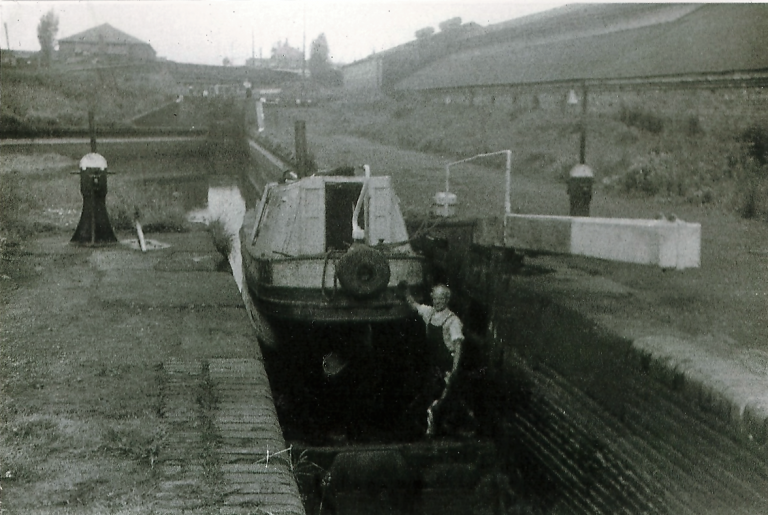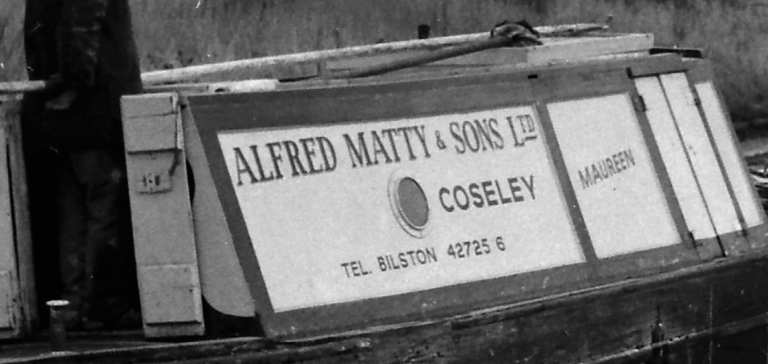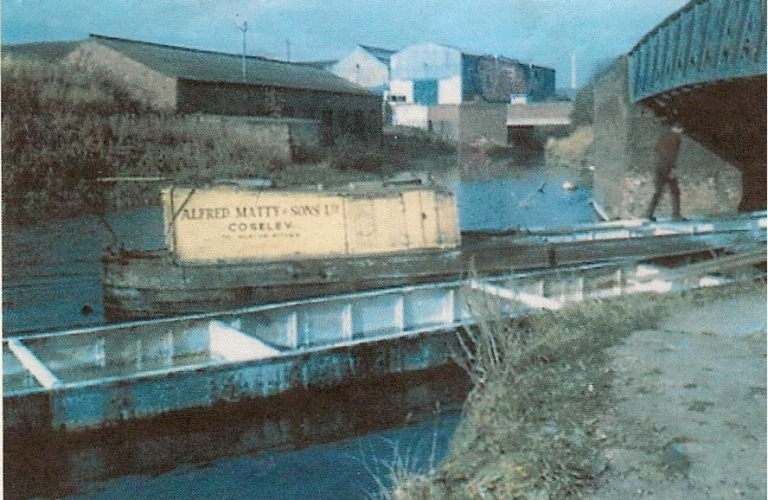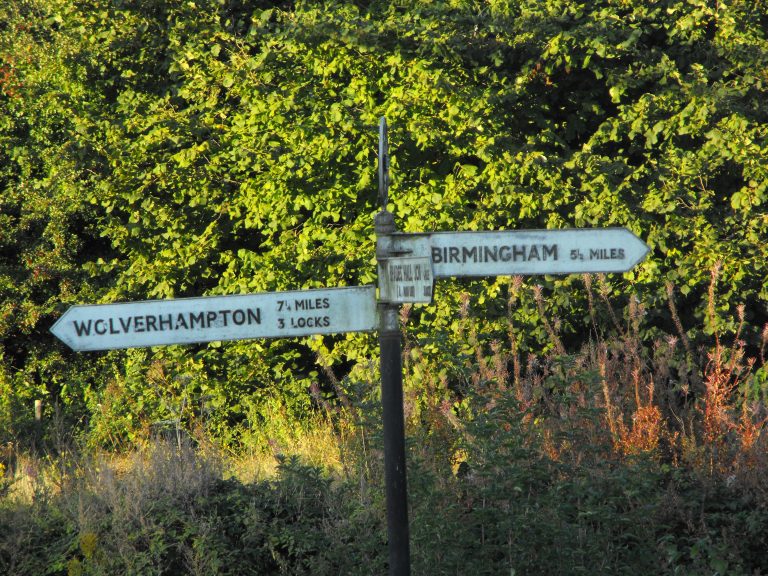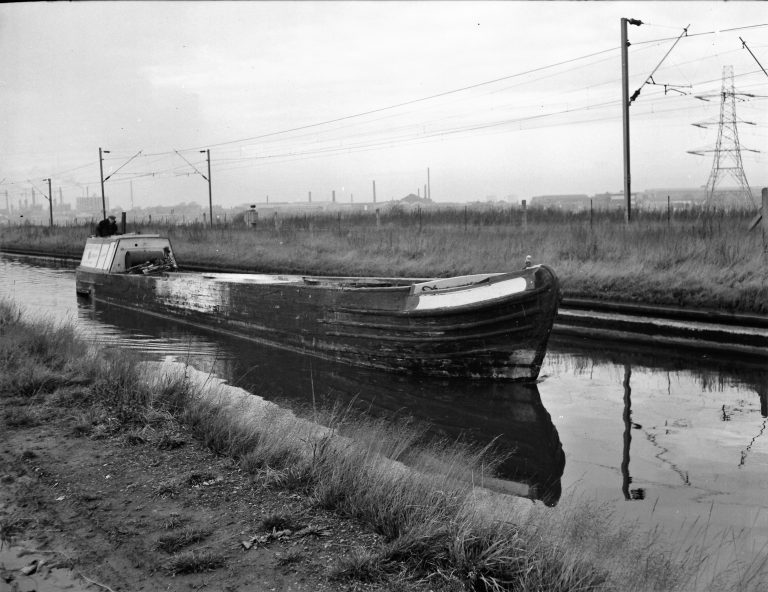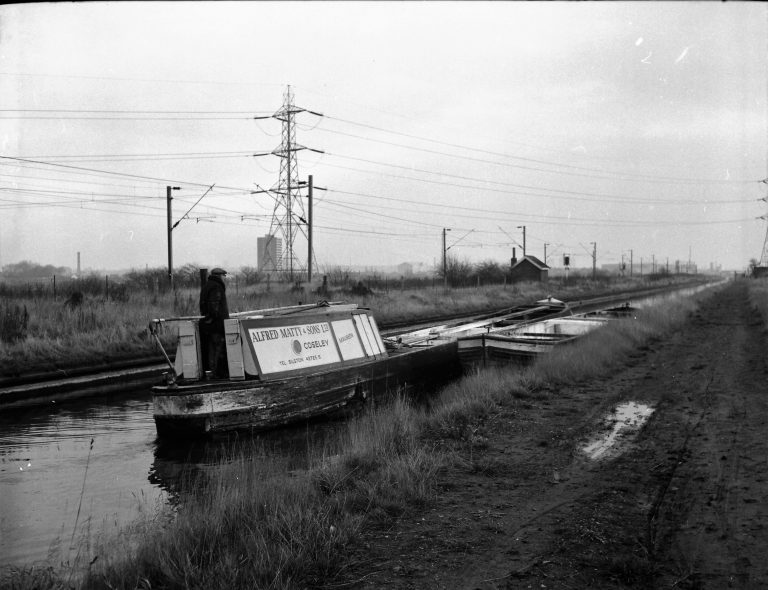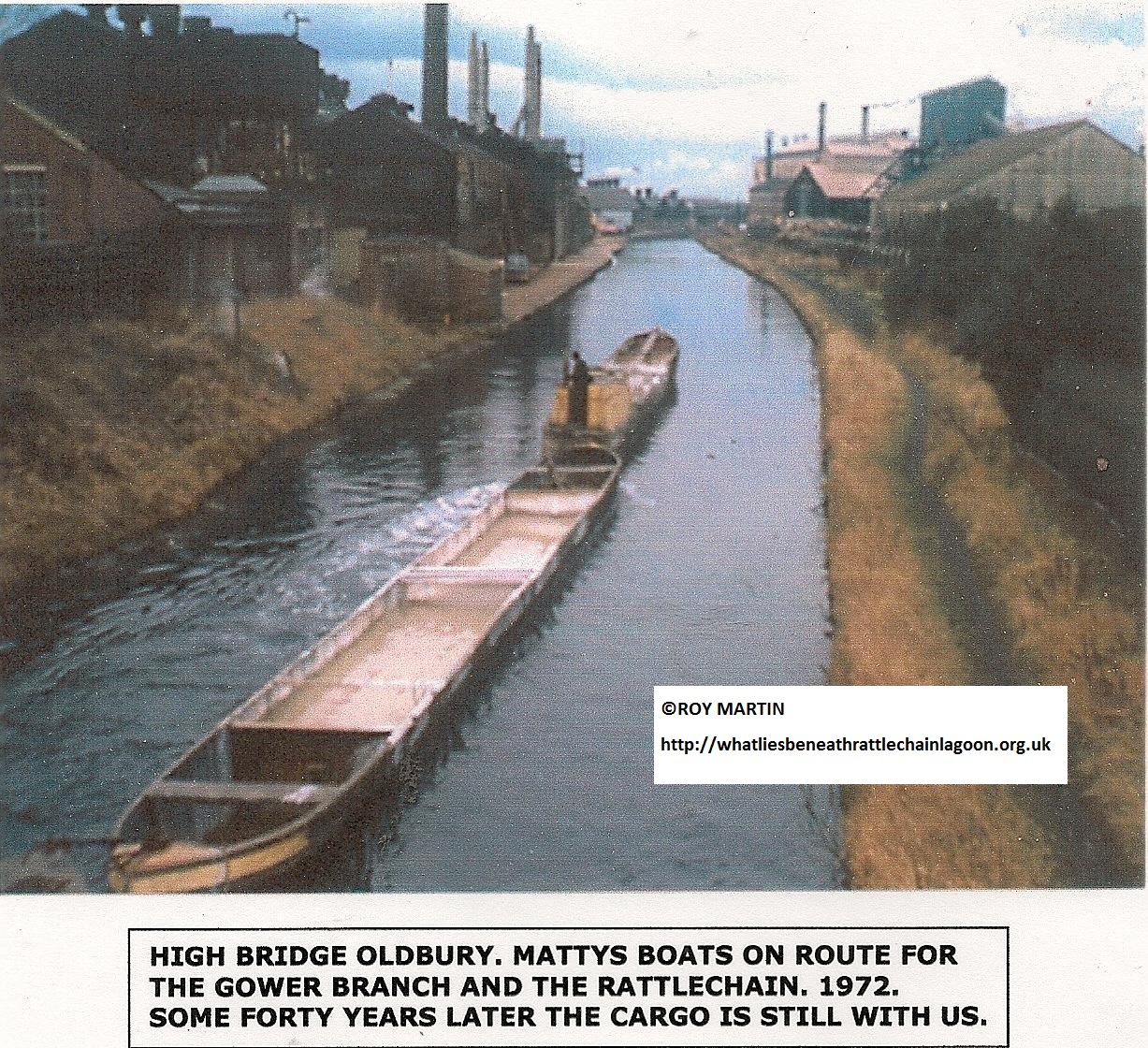A first hand account of a phosphorus waste carrier to Rattlechain Lagoon.
I was under the impression that all of those who worked on the extremely hazardous phosphorus canal waste carrying operation for Albright and Wilson by Alfred Matty’s of Coseley were gone.
But not so!
I have previously outlined this toxic trail from Albright and Wilson’s chemical arm (sometimes known as “The Houghton Arm”) to Rattlechain, and also how this hazardous waste affected the health of one of the men working for Matty’s, Enoch Clewes who described the lagoon as “a place in which nothing could live”.
I was therefore stunned when Paul Bartlett contacted the blog to say that he was one of the very few men who operated the Matty boats on the phosphorus canal traffic and wanted to tell the blog his story!
Paul wrote
“I worked there for about two years starting in March 1972. As well as working the phos boats I also worked the tug Tycho on contract jobs such as laying down pipes ready to carry petrol from the North sea…. myself and Tom Heritage used to work on the canal boats taking the phosphorous waste to the Rattle Chain tip. It was a very heavy sludge which had to be stirred so that it could be pumped out of the boats. If the water / phosphorous mix was wrong and you bumped the boats in the locks or brushed against a bridge, the sludge would catch fire giving of blue flames. To give you an idea how much sludge is in the pool, we used to deliver 8 boats a day for 5 days and 4 on Saturday. Each boat had 20 tons in them.”
I met Paul and recorded his oral history of his time on the canals and specifically his recollections of the phosphorus traffic to rattlechain. He also kindly let me use some of his photographs and original work contract with Matty’s. This is the most compelling account ever described of this journey from a primary source, and the WLBRL team will be creating a youtube video of this using Paul’s record. Watch this space!
There is much to digest here about working practices and other matters, which I will look at at the end of Paul’s story. His words are in blue italics. I have used some links and also pictures from David Wilson and Roy Martin– previous primary witnesses to this trade to illustrate the last phosphorus canal carrier’s tale…..
“My name is Paul Bartlett, and I used to work for Matty’s, a canal company. I used to transport the phosphorus waste from Albright and Wilson’s chemical arm to their Rattlechain Tip at Dudley Port.
(It was) out of an interest in the canals of being one of the founder members of the Dudley Canal Preservation Society. My Dad and I both joined together, and we were the 12th and 13th members. My Father finally ended up being one of the trustees of Dudley canal trust.
But I also used to like boats as I lived in Wednesbury. From the bottom of our garden you could actually see in the distance the Tame Valley Canal, and when I used to go to school, the playground, sports ground was right alongside the Tame Valley Canal. You’d see different boats coming by, which I later knew to be Caggy Stevens, and some of the Len Leigh people…… and I got to know them and I used to cycle along the canal and got to meet all the canal people and the Thomas Clayton people . I became very friendly with Billy Beech, and he taught me how to stem a pair of loaded boats. There was Dennis Moore who used to work for….Keays, Peter Keays- Ken Keay at Walsall, and they had “the Judith Ann” and the metal lister boat.
When they stopped carrying, Caggy took over their cargos, and the boats for them. Ernie Thomas was still about, he had contracts but Caggy used to do those, he was a real character. I met him a few times. I worked his passenger boat for him at times. Then the Lycits had got a contract coming up for Leigh Environmental for taking effluent, pumping effluent to Walsall Wood colliery , but before it actually got underway there was an explosion at the pit and they had to stop putting effluent down it. And with that when Billy Breech heard about it he asked me to go and work for Matty’s, so I went to Matty’s.
It was quite comical, I went for an interview, and Sue Roberts interviewed me, although I got there and it was a foregone conclusion; they wanted me; they knew I could do it, she told me, she sat at this grand desk, and she said “you know Jimmy Yates don’t you? . I said “yeah”. She said this desk is the one his Dad blew his brains out at because he couldn’t stand the trouble that Jimmy and his brothers were causing him.
And I went on the phos, I worked the phos for a bit, then I went on the Tycho and worked the pipe jobs. We had two boats on the pipe jobs, there was myself on the Tycho, and Jack Kent with the Pacific. We also had a tug called “The Governor”, and we had another little motorboat we used as a cabin cruiser that we’d use in an emergency. The motors we had, the Stratford, and The Aldgate which were Grand Union Motors, and The Maureen which was the boat I used which was built for Barlows. It’s got different stories about different names, I was told to call it “The Blake” but it ended up being called “the Maureen” and we believe that was after Neville’s fancy piece”, as he had.
The manager there was a chap called “sarge”, he was a police sergeant from Bilston, and at the time on the boats, there was myself, Albert Brace, Tom Heritage and Jack Kent. There was a lad called “Raffy” on the boat dock, he used to paint and black the boats. And then we had the fitter…sorry I can’t remember his name. I can see him, but I can’t remember his name, he joined while I was there. And he was a good guy he worked on lorry engines and things like that but he got quite fascinated about the boat engines which was really good, he did a good job for the boats.
We had certain boats that were fitted with two stanks for the phosphorus. Basically there was a stank across the middle of the boat, and on either end a few feet back from the bows and the stern. They could also be used for dredging boats as well. The new railway boats, we had a lot of which were completely open so it could be used for anything, any normal cargo, and what Matty’s did, we had metal stretchers which used to go across the boats, and on quite a few we took the metal stretchers out and put chains in instead to hold the boats tight together. On the stank boats , I think we even had chain on those, ’cause we used to go down Tividale locks, they were quite wide, and sometimes the boats would get stuck in them. We got quite good at walking on the chains across the boats, we had a good tight-rope walk at the time.
Working the actual phos boats, we used to start at the arm, and we’d fit up at night, when we got back. I would leave the motorboat underneath (The Maureen), underneath the motorway bridge, because the boat cabin leaked, and the boats weight cabin kept it dry. Then first thing in the morning we would leave the chemical arm, and it’s like an acute junction to get out.
So what we used to do, we had two scaffolding poles, drove into the ground. So you’d come with the motorboat slowly and started off and jump off the stern end of the boat, and the rope, you’d warp it round one pole, feed it out to get the boat swinging, and then the next one to swing it right out, then jump back on the boat, wind the engine up and then you’d got straight up and it pulled the loading boat behind, what was called tail chaining. You had a piece of rope, what, the whole thing would be about 3 foot long, with a piece of rope ,a little length of chain, and a piece of rope again. You had 1 foot 6 of rope, 3 foot chain, then 1 foot 6 rope again, which would go on the stud, which we called “the dolly” on the back of the motor boat. That would go over the dolly on the railway boat that we used.
Matty Phosphorus waste boat Maureen 1972, about to descend the Brades Locks with the railway boat en route to rattechain. Picture Copyright. Roy Martin
We’d go along there till the top of the Tividale locks and turn with a right angle junction. As you got the boat lined up with the lock, we’d approach slowly, then you’d make sure the railway boat caught up with the motorboat. Then you’d make sure the railway boat was on the inside of the motorboat turning right. You’d then take the chain off, the loaded railway boat would push the stern of the motorboat round at 90 degrees. And the railway boat would follow down the boat and because like after the locks at the roving bridge, there was like a seven foot or eight foot gap on the left where the motor boat would go in and the railway boat would right up straight into the lock. So we used to take the railway boat down first, and then we’d go back and take the motorboat down, and we’d couple up at the bottom lock, go down to Dunkirk Stop and we’d used to have to use the left hand side of the stop, because the right hand stop in those days was all silted up.
1965, Matty boat descending the Brades Locks en route to discharge hazardous cargo at rattlechain lagoon. Note the rattlechain brickworks buildings and stack still in evidence to the top left of the picture. Also the staining of chemicals on the boat. Picture Copyright David Wilson, reproduced with permission.
And one day I came down, and this was about 6 o clock in the morning, and a “Noddy boat” (pleasure cruiser) was tied up in the stop. I hoped we didn’t get stuck through! Luckily as my motor boat being loaded went to stop, it pushed all the water in the stop, and the surge against the Noddy boat ripped out his mooring stakes and shoved him out the stop. My words weren’t too pleasant to him!
Then we’d get to the tip, we pulled up alongside the tip. We had a big like log grate, I say log, it was a big chunk of metal, I think it may have been an old railway chair on the chain which was attached to the bank. We’d put that over the side of the boat. We then had like a long shovel, when I say shovel It was like a 90 degree long arm about 15 foot arm.
We used to go up and down the boat with that to get the sludge going again and we’d get the pipe out of the pumphouse, which was about 1 foot diameter , terrible trying to get it without being forced and a right game to get it out, and then we had to prime the pump and that was a right blighter. We had to get the water out of the canal, it was all like a little Villiers hand pump, though the pump was rotary, the main pump to get it going.
And because the phos. used to get into it, it was always corroded. So we’d have to pump like mad, and the one day the handle on it actually broke while I was pumping! So you’d get it all pumped out and so once the motorboat was done, you’d get the two stanks of the motorboat done , you’d then pull the railway boat into position, stir that up, put the pump in that , while that was pumping, you’d then go down with the motorboat to the bank by the Netherton junction and turn the boat round and come back up, then you’d finish pumping the one stank out then put the pipe into the other one , pump that out. Then we’d then come up back the locks, back to the Dunkirk Stop up the locks, back to the chemical arm.
1971, Matty boat Maureen heading in the direction of Oldbury. Note the pumphouse building on the right of the picture on the towpath just partially in shot. Picture Copyright David Wilson, reproduced with permission.
When we got to the chemical arm, what we used to do, we’d let the railway boat go by, come up alongside and then we’d reverse the motor up the chemical arm towing the railway boat up behind it in reverse. So then set ready to go off. We’d then go up to Albright and Wilson’s when they’d loaded. We’d leave the railway boat at the side for the staff to load. But we would then load the motorboat. And it was like a water crane what steam engines use– the arms swung over the boat and it used to pour it in again. We had like a metal log that dredged the bottom to fill it up.
The Albright and Wilson effluent plant on the left, intersected by the chemical arm, and to the right, boats of what appear to be two full cargos of the white phosphorus waste
So we’d do that ,we’d get the boat about loaded up , there would be another railway boat ready, so we’d couple up with that , take that and stop underneath the motorway bridge then carry on do another trip , we did two trips per day. So we did that twice a day with two boats. There’s two of us on it, so we used to do four boats each per day for five days a week. On Saturdays, we used to do two boast each on the morning. The boats would carry about twenty tonnes on the boat, so all in all we’d do between the two of us it was , (thinking) 8, 16 , 20 boats a week, we used to do with the phosphorus tonnage in the sludge. Sometimes, if they didn’t get the mix quite right, we’d get blue flames on top of the tanks in the boat, but we always got as the motorboat went along it sucked the water down and the water would come down about 5 inches either side of the bank and there you would always get a white colour – a greyey/bluey smoke come up all along the canal as you went along.
“The waste itself used to smell awful. You used to get a sting in the back of the throat, so you made sure you didn’t breathe too much in. It was obviously very corrosive, so I used to wear clogs with rubber bottoms on when I was on the phos boats, so you didn’t slip, because it just corroded everything. We were given no protective clothing, no gloves or anything like that. You weren’t told exactly what it was. Our job was to just carry it and take it. In those days there was no health and safety.”
There are many interesting facets of Paul’s story.
Firstly and without any doubt whatsoever, we now have irrefutable evidence that the trade of carrying this hazardous and highly toxic waste by canal continued after The Deposit of Poisonous Wastes Act of 1972. Rhodia and Albright and Wilson , their antecedent, had attempted to claim that this ceased in 1969 and switched to road tanker- FALSE.
Matty’s did Albright and Wilson’s dirty work for them. It is clear that Paul was not given any Health and safety advice by either company- in those days it may not have existed, but even so, Albright and Wilson certainly were checking the health of their own employees and measuring their dental records, and had been for many years. This was obviously for their own litigation reasons. Management were fully aware of the dangers of this substance and of its chronic effects. It is bizarre that this did not extend to their contractors who were taking a far greater risk than the AW employees in being exposed to the deadly cargo- especially carrying it by water in boats that were according to all accounts of a very poor standard.
It is clear that Paul had no protective equipment, unlike the flame retardant Proban overalls or even Harris tweeds that AW staff were given when handling phosphorus at the factory.
The employees at Matty’s were very skilled, hardened to the elements, mostly, but unlike Paul as he told me, uneducated and could not read or write. This made them easy prey. From Paul’s contract it is clear that he was given no pension or sickness benefit. This is unthinkable today. Paul also told me that the story of Enoch Clewes was well known and true within the company, and also that one of his colleagues who carried the phosphorus waste for AW before him had serious health and breathing difficulties before his death.
The environmental risks and problems were also well known and the issues affecting the wider canal area also known. Some of this waste undoubtedly ended up in the canal and made it smell and look foul.
I would like to thank Paul for his time and effort in telling his story, and I believe that it is important that records like this are kept for future reference of our social history. Though the canal carrying trade may be missed, the working practices and environmental deficiencies of hauling this particular cargo from Oldbury will not be. The toxic waste at the tip however is still all there….




